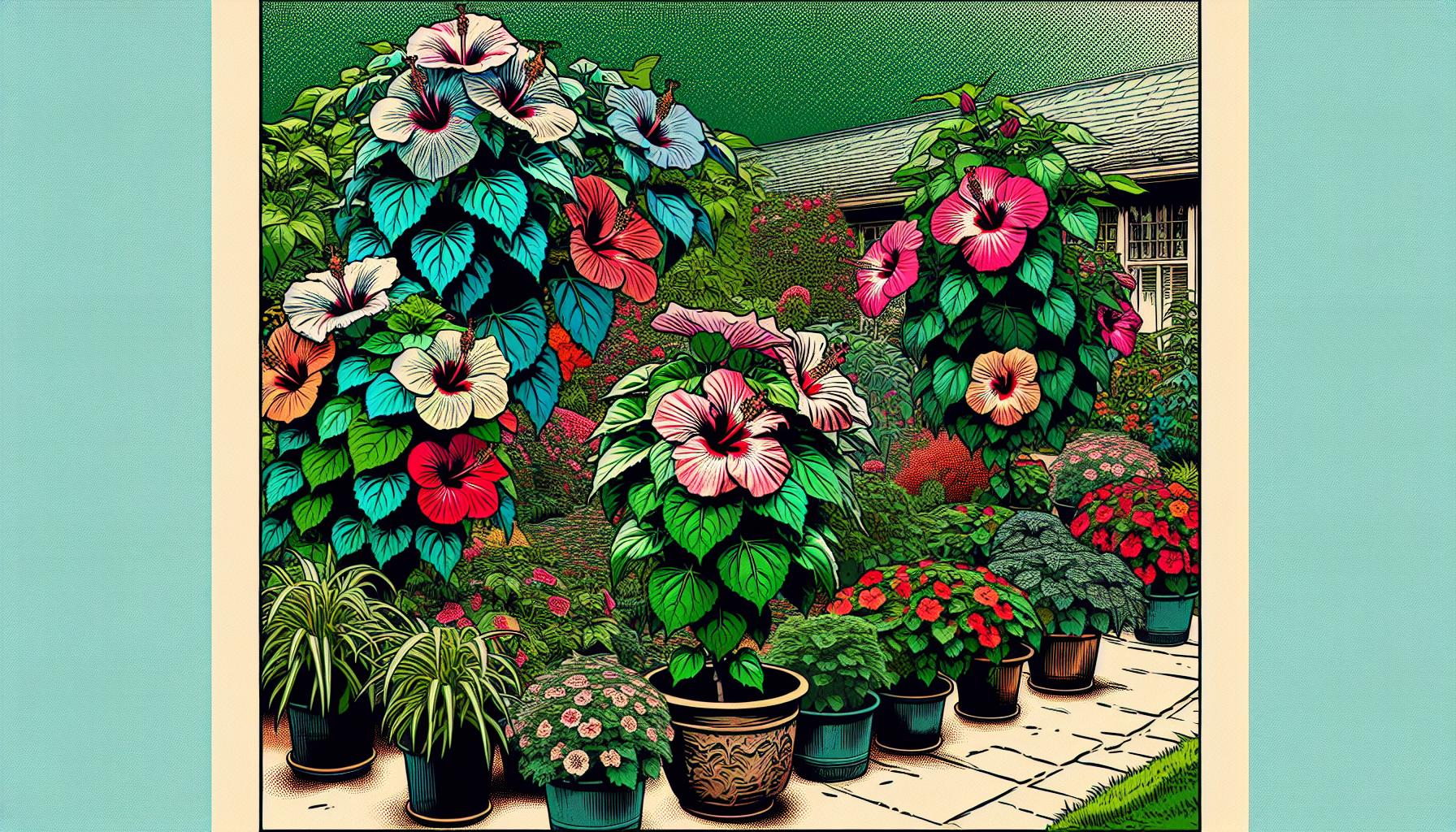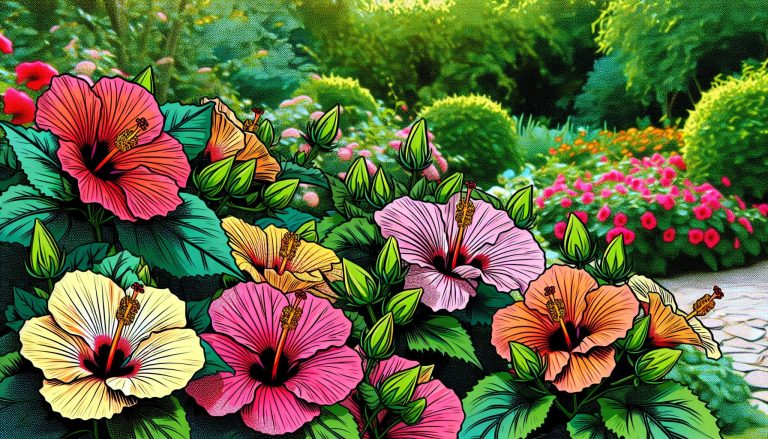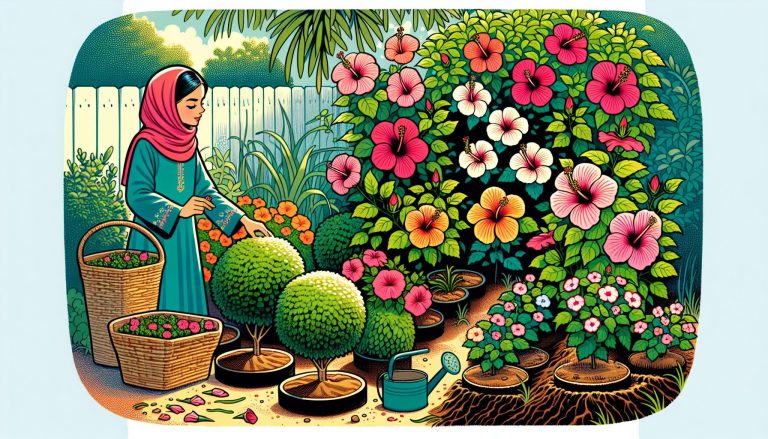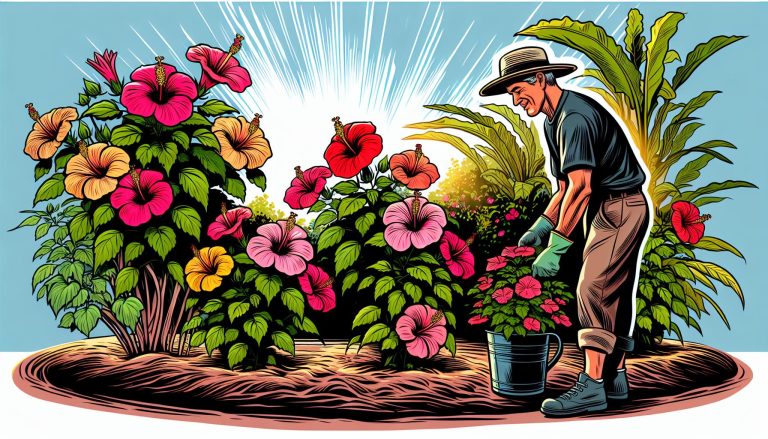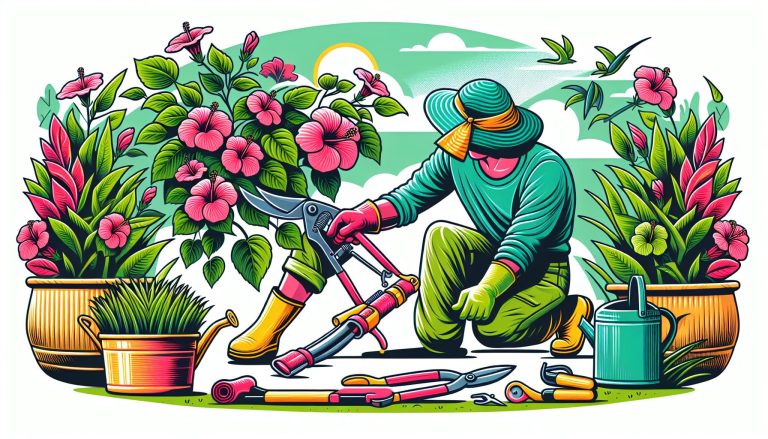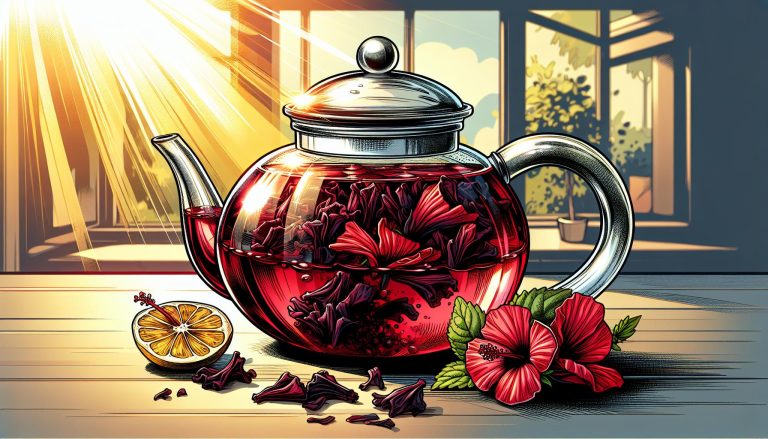Are Hibiscus Perennials? Unlocking the Secret to Year-Round Blooms
As a garden enthusiast, I’ve always been captivated by the stunning beauty of hibiscus flowers. Their vibrant colors and exotic appearance can transform any garden into a tropical paradise. But one question that often comes up is: are hibiscus perennials?
The answer isn’t as straightforward as you might think. While some hibiscus varieties are indeed perennials, others are treated as annuals depending on your climate. I’ll dive into the fascinating world of hibiscus plants, exploring their diverse types and growth habits. Understanding whether your hibiscus is a perennial or not is crucial for proper care and maintenance, ensuring these show-stopping flowers grace your garden year after year.
What Are Hibiscus Plants?
Hibiscus plants are flowering shrubs or small trees known for their large, showy blooms. These tropical-looking plants belong to the mallow family (Malvaceae) and come in various species and cultivars.
Types of Hibiscus
Hibiscus plants are divided into three main categories:
- Tropical hibiscus (Hibiscus rosa-sinensis):
- Native to warm, humid climates
- Evergreen shrubs with glossy leaves
- Produce vibrant flowers in shades of red, pink, orange, yellow, and white
- Hardy hibiscus (Hibiscus moscheutos):
- Also known as rose mallow or swamp hibiscus
- Native to North America
- Herbaceous perennials with large, dinner plate-sized flowers
- Colors include white, pink, red, and bicolor varieties
- Rose of Sharon (Hibiscus syriacus):
- Deciduous shrub native to Asia
- Tolerant of cooler climates
- Produces smaller flowers in various colors
- Blooms later in the season compared to other hibiscus types
Each type of hibiscus has distinct characteristics and growth habits, making them suitable for different garden environments and climates. Understanding these differences is crucial for selecting the right variety for your specific needs and ensuring proper care.
Understanding Perennials vs. Annuals
To fully grasp whether hibiscus are perennials, it’s crucial to understand the difference between perennials and annuals. These terms describe a plant’s life cycle and growth patterns.
Perennials:
- Live for more than two years
- Regrow each spring from the same root system
- Often go dormant during winter
- Examples: Peonies, lavender, and some hibiscus varieties
Annuals:
- Complete their life cycle in one growing season
- Die after producing seeds
- Require replanting each year
- Examples: Marigolds, zinnias, and certain tropical hibiscus
The distinction between perennials and annuals impacts:
- Garden planning and design
- Maintenance requirements
- Cost considerations
- Seasonal color and interest
For hibiscus, the perennial or annual classification depends on:
- Specific variety (tropical, hardy, or Rose of Sharon)
- Climate zone
- Growing conditions
Understanding these differences helps gardeners:
- Choose the right hibiscus type for their region
- Provide appropriate care throughout the seasons
- Set realistic expectations for plant longevity and performance
By recognizing the characteristics of perennials and annuals, I can better explain how different hibiscus varieties fit into these categories and guide readers in selecting the most suitable plants for their gardens.
Are Hibiscus Perennials?
Hibiscus plants can be perennials, but their classification depends on the specific variety and growing conditions. I’ll explore two main types of hibiscus and their perennial characteristics.
Hardy Hibiscus: True Perennials
Hardy hibiscus, also known as rose mallow, are true perennials. These plants:
- Survive winter temperatures as low as -30°F (-34°C)
- Die back to the ground in fall
- Regrow from their root system in spring
- Thrive in USDA hardiness zones 4-9
- Produce large, dinner plate-sized flowers
- Bloom from mid-summer to early fall
Hardy hibiscus cultivars include ‘Luna Red,’ ‘Disco Belle,’ and ‘Lord Baltimore.’ These plants require minimal winter protection in colder regions, making them ideal for gardeners seeking low-maintenance perennial options.
Tropical Hibiscus: Tender Perennials
Tropical hibiscus are considered tender perennials. Here’s what you need to know:
- Native to warm, tropical climates
- Evergreen in USDA zones 10-12
- Treat as annuals or container plants in colder regions
- Require winter protection or indoor storage in zones 9 and below
- Produce smaller, more frequent blooms than hardy hibiscus
- Flower continuously in warm climates
Popular tropical hibiscus varieties include ‘Brilliant,’ ‘President,’ and ‘Painted Lady.’ To maintain these plants as perennials in cooler climates:
- Grow them in containers
- Move indoors before first frost
- Provide bright, indirect light during winter
- Reduce watering and fertilization
- Prune lightly to maintain shape
By understanding the perennial nature of different hibiscus types, you’ll make informed decisions about plant selection and care for your specific climate and gardening needs.
Growing Hibiscus as Perennials
Growing hibiscus as perennials requires understanding their specific needs and adapting care practices to your local climate. I’ll explore key considerations and techniques to help you successfully maintain these stunning plants year after year.
Climate Considerations
Climate plays a crucial role in growing hibiscus as perennials. Hardy hibiscus thrives in USDA zones 4-9, withstanding temperatures as low as -30°F (-34°C). Tropical hibiscus, however, only survives outdoors year-round in zones 9-11. In cooler regions, I grow tropical hibiscus in containers, allowing for easy relocation when temperatures drop. Adequate sunlight is essential; hibiscus requires 6-8 hours of direct sunlight daily for optimal growth and blooming. I ensure proper drainage to prevent root rot, especially in areas with heavy rainfall or high humidity.
Overwintering Techniques
Overwintering techniques differ based on hibiscus type and local climate. For hardy hibiscus, I cut back the stems to about 6 inches above ground level after the first frost. I then apply a 3-4 inch layer of mulch around the plant base to insulate the roots. Tropical hibiscus in colder regions requires more protection. I move container-grown plants indoors before the first frost, placing them in a bright, cool area with temperatures between 50-60°F (10-15°C). For in-ground tropical hibiscus, I build a protective structure using stakes and burlap, filling it with dry leaves or straw for insulation. In milder climates, a thick layer of mulch and frost cloth may suffice to protect tropical hibiscus during brief cold spells.
Benefits of Perennial Hibiscus
Growing perennial hibiscus offers numerous advantages for gardeners. These stunning plants provide long-lasting beauty and value to landscapes with minimal effort. Here are some key benefits:
- Long-term investment:
- Reduce yearly planting costs
- Establish mature, impressive plants over time
- Increase property value with established landscaping
- Low maintenance:
- Require less frequent replanting
- Develop stronger root systems, improving drought tolerance
- Need fewer inputs of fertilizers and pesticides over time
- Environmental impact:
- Support local pollinators with consistent nectar sources
- Improve soil structure through extensive root systems
- Reduce carbon footprint by minimizing annual replanting
- Seasonal interest:
- Provide reliable blooms year after year
- Offer attractive foliage even when not in flower
- Create winter interest with seed heads and plant structure
- Versatility in design:
- Use as foundation plantings, hedges, or focal points
- Combine with other perennials for layered garden designs
- Adapt to various garden styles, from formal to naturalistic
- Improved performance:
- Increase flower production as plants mature
- Develop resistance to local pests and diseases
- Adapt to specific microclimates in the garden
By choosing perennial hibiscus, gardeners can enjoy these benefits while creating stunning, sustainable landscapes that improve with age.
Common Varieties of Perennial Hibiscus
Perennial hibiscus varieties offer gardeners a diverse range of options for adding vibrant, long-lasting beauty to their landscapes. Here are some popular perennial hibiscus varieties:
- Hardy Hibiscus (Hibiscus moscheutos):
- ‘Luna Red’: Large, 6-8 inch red flowers
- ‘Disco Belle White’: Dinner plate-sized white blooms with red eyes
- ‘Lord Baltimore’: Brilliant red flowers up to 10 inches wide
- Rose of Sharon (Hibiscus syriacus):
- ‘Blue Chiffon’: Double blue-purple flowers
- ‘Red Heart’: White flowers with a red center
- ‘Lil’ Kim’: Dwarf variety with white flowers and red centers
- Swamp Rosemallow (Hibiscus coccineus):
- Native to southeastern U.S. wetlands
- Striking red flowers with deeply lobed leaves
- Confederate Rose (Hibiscus mutabilis):
- Flowers change color from white to pink to red throughout the day
- Can grow up to 15 feet tall in warm climates
- Texas Star Hibiscus (Hibiscus coccineus ‘Texas Star’):
- Star-shaped red flowers
- Thrives in moist soil and full sun
These perennial hibiscus varieties offer unique characteristics in terms of flower size, color, and growth habits. Hardy hibiscus and Rose of Sharon are particularly well-suited for colder climates, while Swamp Rosemallow and Confederate Rose thrive in warmer, more humid environments. By selecting the appropriate variety for your specific climate and garden conditions, you’ll ensure a stunning display of perennial hibiscus blooms year after year.
Caring for Perennial Hibiscus
Proper care is essential for maintaining healthy and vibrant perennial hibiscus plants. By understanding their specific needs, you’ll ensure your hibiscus thrives year after year, providing stunning blooms throughout the growing season.
Soil and Sunlight Requirements
Perennial hibiscus plants thrive in well-draining, rich soil with a pH between 6.5 and 7.0. I recommend amending your garden soil with organic matter to improve drainage and fertility. These plants require full sun to partial shade, ideally receiving 6-8 hours of direct sunlight daily. In hotter climates, provide afternoon shade to protect the flowers from scorching.
Watering and Fertilizing
Hibiscus plants need consistent moisture to produce their large, showy blooms. Water deeply and regularly, keeping the soil consistently moist but not waterlogged. During hot, dry periods, increase watering frequency. Apply a slow-release, balanced fertilizer in spring when new growth begins. For optimal blooming, use a fertilizer with a higher phosphorus content (the middle number in the N-P-K ratio) during the growing season. Avoid over-fertilizing, as this can lead to excessive foliage growth at the expense of flowers.
Conclusion
Hibiscus plants offer a world of beauty and versatility for gardeners. Whether you choose hardy or tropical varieties they can be grown as perennials with the right care and climate considerations. By selecting appropriate varieties understanding their needs and providing proper maintenance you’ll enjoy stunning blooms year after year. Perennial hibiscus not only add long-lasting color to your garden but also support local ecosystems. With their low maintenance requirements and impressive flower displays these plants are a fantastic choice for both novice and experienced gardeners alike.

